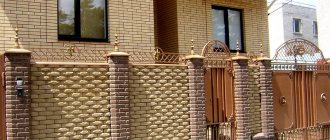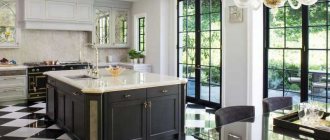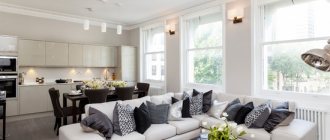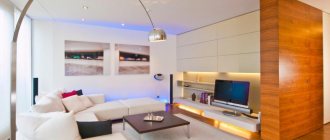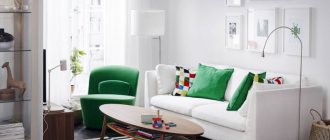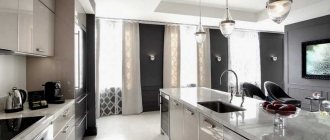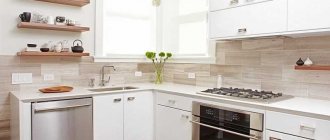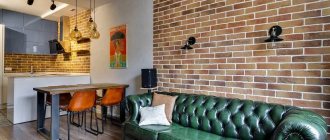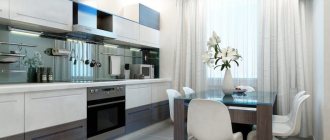Red and white brick in the kitchen
A red brick wall is considered the most popular solution for finishing kitchen spaces. The red color and its shade palettes look great against the backdrop of various interiors.
Often, brick design is used to decorate the apron area in the kitchen, or in the free area between the sink and the upper storage shelves. Do not forget that the material needs care, which consists of protection and impregnation.
A unique idea that adds elements of modern style to the interior is to create a white brick kitchen. This solution is more relevant to the Scandinavian style, where the main colors are white or gray. Light or red bricks can be purchased at any building supply store.
Brick in the kitchen interior
A brick wall can be the remnant of a plastered or reclaimed wall. This solution is especially recommended in old houses and apartment buildings. These types of interiors will ideally match the loft style or a more classic version. For owners of new apartments, tiles of small thickness are best suited; when glued to the wall, they give the effect of an old wall and do not load or take away valuable centimeters from the surface of the room.
Some models are deliberately aged, which adds to their charm. The most classic brick is red, although bricks painted white or graphite are no less interesting. A characteristic feature of all brick structures is uneven color and uneven structure. You can highlight it even more with the right lighting.
Advantages of brick and masonry
The main advantages of finishing a wall with brick are as follows:
- attractive appearance;
- effective combination with light, brown, beige and other neutral shades;
- the possibility of combining brick with any finishing materials - wood, glass, metal and so on;
- use as a separate decorative solution in various stylistic directions;
- strength and reliability of the material;
- resistance to damage, loss of initial color and moisture.
While pointing out the advantages, it is also worth highlighting the muffling properties of the material. If you make a brick wall out of it, there is a high probability that the sounds present in the room will be quiet.
Material options
A wide selection of the most ancient building materials is offered for sale. Additionally, there are various techniques to imitate fashionable brickwork with less cost and effort.
Types of red brick
The most common brick is red or ceramic. It is obtained by firing clay and its mixtures. Available in shades of yellow, burnt red and brown. Ceramic clinker bricks made from refractory layers of pure plastic clay without impurities are an expensive and high-quality material.
Fireclay or stove - made from special clay “chamotte” and some additives, suitable for stoves and fireplaces.
Expensive hand-molded bricks and figured bricks of any shape, texture and color are used to decorate masonry and fireplaces.
White brick
White brick in the kitchen is an elegant material that designers use in various ways. It can be white by nature - if it is a silicate material consisting of purified sand and lime. It is also possible to imitate silicate using coloring and other techniques. Having a kitchen with white brick in the design will add lightness to the interior.
Which material to buy to imitate brick
If for some reason it is not possible to use natural brick in kitchen design, then there are options to use the following materials for imitation:
- decorative tiles;
- Wall panels;
- polystyrene foam and drywall;
- decorative plaster;
- wallpaper and paint.
Tile
There are various options for decorative tiles - clinker, gypsum, stone. All of them are easy to care for, durable, moisture-resistant, resistant to chemicals, and have low cost and weight. The tile production technology allows you to reliably imitate brickwork.
Wall panels, foam and drywall
You can imitate a brick wall using panels made of plastic or MDF, which are lightweight, easy to install, easy to maintain and replace. It is better to place them on a surface that is not adjacent to the stove - a source of increased temperature.
Polystyrene foam is a lightweight and easy-to-work material. Allows you to create with your own hands an imitation of masonry with a characteristic uneven surface. Drywall is easy to process, but not moisture resistant. But you can make structures of any shape from it. Economical replacement for expensive natural materials.
Decorative plaster
One of the simplest finishing methods is plastering walls with imitation masonry. The plaster is easy to apply and repair, durable, and has the ability to conserve heat. Disadvantage: instability to pollution.
Wallpaper and brick paint
Wallpaper is the most affordable way to decorate walls in the desired style. That’s why designer wallpapers with imitation masonry are popular in decoration and differ from a brick wall only to the touch. Disadvantage: fragility.
On a flat wall, you can paint the desired design with water-based or acrylic paint, which can be done as easily as possible with a roller or brush. This budget option will look modest, but the painted wall is easy to clean.
DIY brick
You can save on natural material by making it yourself. To do this you will need: get clay, prepare clay dough, make molds and fill them with clay. The resulting blanks are dried and fired in a special oven. Having a clay quarry in mind, you can take a chance and organize a small brick production.
Disadvantages of Brick Wall Design
A brick-style kitchen, despite its positive characteristics, has some disadvantages, namely:
- heavy weight of material;
- massive appearance, visually reducing free space;
- feasibility of use in large kitchens;
- presence of significant fat absorption properties;
- the need for systematic cleaning.
If the kitchen has a small area, designers recommend using a different design option, or choosing imitation brick. When decorating a wall with brickwork, it is advisable to place the material behind glass to prevent greasy drops and water from getting on it.
Advantages and disadvantages
This material has earned popularity not only for its aesthetic and creative component. Other advantages
bricks and masonry are:
- relatively low cost;
- moisture resistance, which is an important property for a kitchen;
- resistance to temperature changes and fire safety. Therefore, it is often used in the design of an apron;
- durability and strength. It is difficult to damage such material, and even if this happens, then with such finishing an insignificant chip or scratch will not be noticeable and the repair will not have to be redone;
- ease of use. Even an inexperienced master can learn to work with it;
- unusual solution;
- combines with other items;
- excellent option for zoning;
- environmental friendliness.
It's fair to note the downsides
.
- Firstly, the material is heterogeneous. A rough surface is not so easy to clean from dust and dirt particles that accumulate in the kitchen more often.
Today, there are special impregnations for treating surfaces and seams, which can significantly minimize this disadvantage.
- Secondly, despite the fact that brick is suitable for many interiors, it is difficult to fit it in doses so that it looks stylish and harmonious. You need to consult with professional designers, or create a 3D project yourself in the program.
Kitchen project with a brick wall
- Thirdly, such material does not reflect light. And dark shades even visually absorb it.
Artificial lighting will also need to be considered so that in the evening the interior remains attractive and not gloomy.
Brick finish on the entire wall
The kitchen design, made by finishing one or more walls with brickwork, will look original due to the correctly selected household equipment.
A brick wall can be the basis for subsequent decoration of the kitchen space. The surface, made of old-style red brick, always looks elegant and is suitable for creating a modern style.
Design ideas
Imitation of masonry in combination with wood looks harmonious, stylish and allows you to achieve a unique, cozy and warm atmosphere in the kitchen. A wooden kitchen set will especially stand out against the background of a red-brown brick finish. The natural color scheme of the brick highlights the natural wood tone, while the natural texture of wood smoothes out the roughness of the brick finish.
An unusual solution is the use of facing material with an aging effect. A plane lined with glass or mirror bricks looks no less original when decorating a kitchen.
The photo shows a brick wall in the kitchen combined with a set of natural wood.
For a kitchen interior in an antique style, it is appropriate to use classic masonry to decorate a modern stove. Decorative bricks are used to lay out the portal, as well as a false panel that covers the hood and create a structure similar to a fireplace chimney.
The photo shows a kitchen design with photo wallpaper imitation aged brick.
Brick over kitchen countertop
The area above the countertop requires special finishing due to its sensitivity. If you have chosen a regular red brick to decorate a brick apron in your kitchen, you must be prepared to constantly care for its surface. In addition to daily care, the material requires periodic impregnation.
For those who like to experiment, decorating an apron with black brick is suitable. His chic appearance is fraught with a certain mystery. A black apron in the kitchen goes well with wooden accessories and gray furniture. A combination of black and white tones will also be an obvious design option.
Useful tips
What you need to consider when choosing a brick wall for the kitchen:
- Natural brick looks great in the dining area or on a non-working wall, but it is not suitable for a backsplash. For the cooking area, it is better to choose ceramic tiles with an appropriate design.
- If you want to completely decorate one of the walls with brick, you should choose the one that is best illuminated by the sun.
- You shouldn’t line all the walls of the kitchen with brickwork, otherwise the room will be no different from a basement. It is best to use this material as a link between zones or as decoration for openings.
- A brick kitchen should be illuminated as much as possible. For this, not only lamps and spots are used, additional lighting of furniture and tabletops will also not be superfluous. To allow more light into the room, you should not close the windows with curtains that are too thick.
Lamps should fit organically into the interior of the kitchen - Cladding tiles can be used to decorate not only the surfaces of walls or floors, but also furniture. Brick is suitable for simulating a fireplace or creating a real home, if we are talking about a private home.
- A brick ceiling is an original solution, but is only suitable for private houses. In modern apartments, such decor not only looks too bulky, but can also be dangerous.
- If the walls of a house or apartment are made of brick, they do not need to be subjected to additional processing. But if you wish, you can paint some of the surfaces or highlight niches and protrusions with a different color.
The general design rule is that for a small kitchen it is better to use light colors, while dark ones are appropriate in spacious rooms with large windows.
All of the above are not the only ways to use brick in the kitchen interior. With proper imagination and taste, you can create a unique design.
See alsoLight green kitchen design
General design rules
Before you start designing a brick kitchen with your own hands, it is important to know the main points on which many important factors depend. So, the following list of points plays an important role in finishing.
Choosing the right brick color. In a small kitchen, it is recommended to choose light-colored material. It is advisable to use dark brick to decorate a kitchen with a sufficient level of lighting.
The choice of color should depend on the design direction. Thus, in a Scandinavian-style kitchen it is advisable to use white and gray tones of material.
Selecting a wall. It is necessary to lay bricks or paste wallpaper with such a pattern on the wall that is most illuminated by light.
Since the highlighted area will be the focal point of the entire design, you need to carefully work on its appearance. In the shade, the brick finish of the kitchen looks gloomy and inconspicuous.
Decorating one of the walls. It is not recommended to finish using a brick pattern on several walls at once. In spacious kitchens with good lighting, the option of repeating the design of two walls in some cases looks good.
However, in many apartments the area is not large enough to allow this design option. But it is permissible to highlight a separate accent on one of the walls in a small kitchen.
Types of material
Brick is not only a dark red or white color and a rough surface. Different materials allow you to choose the desired shades and texture, even gloss or mirror shine.
Crushed brick - a fashionable solution for interiors in industrial or rustic styles
See also Wall design in the kitchen: what to pay attention to.
Natural brick
If the owners of the apartment are lucky and it is located in an old house, natural brick is the simplest finishing option for the kitchen. It is enough to remove the old coating to get to the brick. To give the surface a presentable appearance, it is coated with varnish or paint. An additional layer will protect the brick from dirt and dust; this finish is easier to care for in the kitchen.
If you live in a house with brick walls, just remove the plaster to get a beautiful finish
A brick wall can be artificially aged using craquelure, or covered with plaster, preserving the texture of the masonry. Another decor option is a transparent glass panel. It will protect the brick from any impact and at the same time visually expand the space, adding more light.
See alsoIndustrial style in the interior
Facing
Due to its small size and thickness, such bricks can be used even in a very small kitchen. Small masonry will not make the space narrower or smaller, and due to its size it is convenient to use on any surface. Facing brick is well suited for window and door openings or kitchen aprons.
The facing brick itself has a fairly smooth surface
See alsoDesign of a children's room for a girl 12 sq.m. m.
Ceramics
Ceramic tiles with a brickwork effect will suit any interior style. The variety of textures, colors and sizes allows you to use this material in a variety of combinations. A design inspired by natural stone is suitable for Provence, country or Scandinavian style, and glossy surfaces are a godsend for minimalism or hi-tech.
Ceramic tiles imitating brick or stone are one of the most popular finishing options.
Tiles with a glossy surface will be easier to clean
See also Kitchen design 6 sq. meters: choice of style, furniture, lighting.
Other materials
Real brick is heavy and bulky, making it an unsuitable cladding option for thin walls. Glass panels with a brick pattern or thick vinyl wallpaper with a suitable texture will be a good replacement.
The fastest way to decorate the interior is to finish it with “brick” panels, which are of quite high quality and practically do not differ from natural material.
| comparison table | ||
| Finishing | pros | Minuses |
| Natural brick | Strength, resistance to fire and temperature changes, durability. | Rough surface, difficult to maintain, risk of mold developing in the seams, poor choice of shades. |
| Facing | Lightweight, compact, many cladding options, rich palette. | High cost of work, appearance of a white coating over time. |
| Ceramics | Strength, wear resistance, ease of maintenance, not afraid of water and fire. | Price, complexity of work. |
| Glass panel | Environmentally friendly, easy to install and maintain, durable. | Price, relative fragility, dust and grease stains are immediately visible. |
| Wallpaper | Choice of textures and shades, low cost, easy to care for. | Some types of wallpaper cannot be washed, they are a fire hazard and are not durable. |
See alsoKitchen design 2021: fashionable interior design solutions
Dark colors
Brickwork can be done using several approaches, namely:
- cover the wall with colorless matte or glossy varnish;
- paint in the desired color.
Today it is important to paint a brick wall in a tone similar to the others.
The classic option is a dark brown design. In large kitchens it looks extraordinary and chic.
Brick apron
Update your kitchen with a rustic decor with an attractive stone look backsplash at a very affordable price. Available in roll sizes, the stone is easy to install to provide a high-quality image of actual stacked stones.
Simply clean the wall surface well, remove the vinyl backing, and carefully position the backsplash, using a sharp utility knife to cut all the holes. Your rustic or cottage style kitchen will be beautifully updated and the wall will receive additional splash protection.
Loft
To carry out a design in a similar direction, it is impossible to imagine a material of a different type. Rough design in combination with decor creates a “natural” atmosphere.
Brick look tiles
Calculate the exact cost of repairs using an online calculator
and receive a free detailed estimate for repairs
Calculate
In modern interiors, people often abandon natural materials in favor of artificial ones due to their low cost. Brick was no exception either. There are many options for decorative tiles made to look like brick; they are easier to install and maintain. A similar solution is often used to decorate a kitchen apron.
Photo: swavla.com
Scandinavian
This style often uses white and gray tones, or combinations thereof.
Compared to the loft style, here the brick looks more natural. At the same time, the design looks simple and tasteful. A wall in this design will be highlighted and bright.
Color combinations and preferences
A huge advantage of the brick texture is its ability to harmonize with almost any color scheme of other surfaces. The only undesirable combinations are those in which red and reddish shades overlap. The best option would be a brick kitchen apron or one of the walls, but even they need good lighting.
Brickwork in the kitchen Brick in loft decor
Brick in a loft style kitchen
If you decorate all horizontal surfaces with masonry, you will get the appearance of castle walls, but this can be avoided by using whitewash or white brick in the interior. Provence, country and Scandinavian style allow such a design solution, including brick-look wallpaper in the kitchen. The room turns out textured, interesting and filled with light.
Rustic styles with brick look good both in country houses and in ordinary apartments. They seem to take you back to times past, where everything is filled with comfort, warmth and the smell of fresh bread.
Brick decor in the kitchen in the attic Brick in the kitchen in the Art Nouveau style
It should be noted that colorful carpets, contrasting curtains with bright patterns, and photo wallpapers are contraindicated for this dominant element of the interior. The brick kitchen interior is self-sufficient and does not tolerate competition. It attracts the main attention, and everything else serves as a complement. Theoretically, it is possible to maintain a balance and combine the above textures with brick-like wall decoration, but this is a very difficult task that only a true professional can do. Therefore, it is better to limit yourself to one active element, which can be:
- terracotta;
- yellowish-sand;
- red;
- gray;
- white;
- black.
Brick decor in a small kitchen
The color is determined either by the natural properties of the material or by the selection of paint that covers the brick wall. It doesn’t matter what exactly is used in the work: decorative brick, natural brick, imitation tiles or textured wallpaper, the rules are the same for everyone.
Brick wallpaper in the kitchen
Provence or country
Brick is often used to create a romantic Provence or country style. Moreover, it is important to observe an important condition - the finished design should look natural or be artificially aged.
It is advisable to use light shades, such as white, milky, light olive and others. One has only to look at the photo of a brick kitchen, how such a range emphasizes a unique feature - the bright illumination of the room with light.
Examples for the kitchen-living room
With the help of bricks you can zone a combined space in an original way. It is appropriate to use decorative masonry to lay out a dining area with a dining table or a place to relax. The partition between two functional areas is finished with red, white, yellow or any other brick that matches the overall color scheme of the interior.
The photo shows a kitchen-living room with walls decorated with bricks of different colors.
An interesting option is to create a combined cladding from bricks of several shades. This way you can not only divide, but also decorate the combined space.
Pop Art
A brick-colored kitchen design created in this style looks creative and original. The interior of a room may contain several shades at once.
The presence of brightly colored accessories in the room against a brick background looks bright and catchy.
Decor with a brick wall
Accessories are selected depending on the style.
For example, in romantic Provence, vintage items, forged flower stands, clay pots, and aged wood go well with brick.
The pop art interior will be complemented by bright posters, paintings and textiles in rich colors.
In the loft style, in combination with such a finish, candlesticks, interesting lamps, wooden photo frames, forged figurines, and rough wooden shelves will look great.
Antique clocks, mirrors, artwork and posters also work well with brick finishes.
Source
Mediterranean
The design style conveys the atmosphere of a resort town. Being in such a kitchen, one can assume that there is a sea outside the window. The created style includes a combination of white and blue shades. In this case, the brick wall can be painted sea green or sandy.
Currently, designers often use brick wall finishing options. Over time, interest in this option does not disappear. Many people like to use finishing materials that imitate a brick pattern. And for good reason, because it looks stylish and beautiful.
Types of decorative materials and their location in the interior
Thanks to modern materials and an abundance of information, almost any flight of fancy can be realized in the interior. Brick kitchen? Please! It’s not difficult, the main thing is to decide what material to use in the design. Can choose:
- natural terracotta brick;
- silicate gray (so-called white) brick;
- finishing brick;
- decorative plaster;
- wall panel;
- white brick-like tiles;
- textured wallpaper.
White brick in the kitchen Brick in a classic kitchen interior
Kitchen decoration with brick is no longer at the peak of popularity, but it is not losing ground either. This technique is out of fashion, it has a certain rough charm and appeal. It is pleasant to be in a kitchen decorated with brick, in one form or another, because it creates an atmosphere of sincerity and the illusion of simplicity. In fact, the use of these textures requires a competent approach so that the cozy world does not turn into a fishing hut or a dilapidated shed. Here it is necessary to observe the measure, understand what quantity is appropriate and what is best to combine decorative bricks with in the kitchen interior.
Decorative brick-like tiles in the kitchen
Brick in the decor of a country house
Additional cladding of the internal walls adds strength to the house and helps retain heat. But, like any additional layer, it reduces the area of the room. This should be taken into account when choosing material.
Sometimes it is more appropriate to prefer imitation, using decorative brick in the interior of the kitchen. Now the trend is to place it on only one wall, which thus stands out against the general background and becomes the dominant accent. This can be a free surface or a brick kitchen apron, a wall or a specially constructed partition. Other background surfaces are decorated neutrally; pastel colors are most often used. Otherwise, the space may be overloaded, which can lead to an unpleasant heavy atmosphere.
Brick apron in the kitchen
Brick in a high-tech interior
A brick wall in the design of any room is quite an active element, especially when the masonry is a bright terracotta color. If gray or yellow material is used in combination with neutral tones of other large surfaces (floor, ceiling, walls), the interior becomes more light. The combination of masonry with pastel colors visually lightens the space. As an addition, it is logical to use bright textile accents or contrasting furniture. A brick kitchen requires the presence of many furnishings and household appliances; this should also be taken into account when planning decorative surfaces.
Brick tiles in the kitchen
Brick in a country style kitchen
Photo of a brick kitchen
Features of laying tiles with bricks in the kitchen
When the walls are level and ready for laying tiles , apply markings on them depending on the chosen brick placement pattern.
Follow the following sequence of steps to stick the tiles correctly:
- Apply a thin layer of glue to a section of the wall.
- Apply adhesive solution to the part.
- Press the piece firmly against the wall. To ensure even seams, use plastic spacers.
- To imitate brickwork, place each subsequent brick offset by half the part.
- Remove any excess glue that comes through the seams immediately with a rubber spatula.
- Seal seams between decorative elements. This can be done with a special grout or adhesive solution.
On a note. Use special adhesive to lay tiles. The adhesive suitable for a particular tile is most often indicated on the product packaging.
